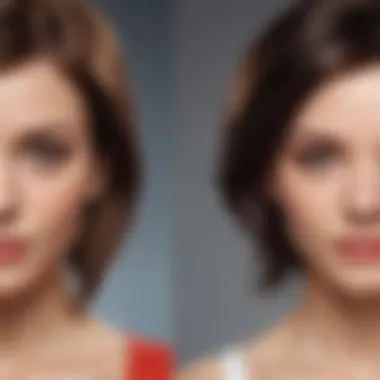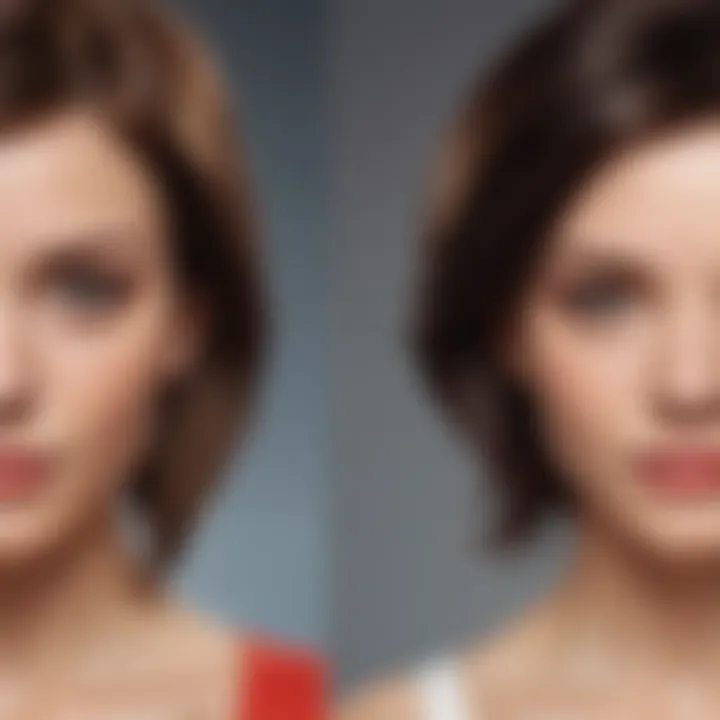Digital Makeovers: The Rise of Virtual Hairstyle Trials


Intro
In recent years, the technology behind virtual hairstyle trials has become increasingly sophisticated. This trend not only revolutionizes the way consumers engage with hairstyles but also reflects broader shifts in the fashion and beauty industries. This article delves into the transformative impact of these virtual trials, examining how they enable individuals to experiment with different looks without making permanent changes. As we explore this topic, we will consider the technologies involved, benefits for users, and the implications for beauty standards.
Fashion Trends
The integration of virtual hairstyle trials in fashion is evident in the seasonal styles emerging every year. Individuals can now use applications to visualize how a new haircut or color will suit their unique features. This capability allows users to navigate trends with reference to their own preferences.
Seasonal Styles
With each new season comes a flurry of fashion trends that influence hairstyle choices. In spring and summer, for example, lighter, more playful styles often emerge. Shades like caramel or honey blonde may become fashionable, appealing to consumers looking for a sun-kissed look.
Conversely, fall and winter might see a return to deeper, richer hues such as burgundy or deep chestnut. This seasonal shift emphasizes the importance of being able to visualize and trial different colors and cuts ahead of investing in a new look. Today, digital platforms are at the forefront of this visual experimentation, reducing the fear associated with making a significant hairstyle change.
Influencer Inspirations
The role of social media influencers cannot be underestimated in driving hairstyle trends. Influencers like Chiara Ferragni and Aimee Song often showcase new looks that followers may wish to replicate. Here, virtual hairstyle trials become a bridge for consumers.
By mimicking these styles digitally before committing to them, consumers leverage technology to transform what may be fleeting trends into their lasting personal styles. This practice encourages a more diverse representation of beauty, as users can experiment without any pressures or biases inherent in the traditional salon experience.
Beauty Tips
Understanding your hair type is the first step in achieving the perfect look. However, conferring with professionals or online resources is key. The combination of these traditional approaches with technology offers a comprehensive perspective.
Skincare Routines
Complementing a new hairstyle with an effective skincare routine is crucial. A well-cared complexion can enhance any hairstyle. From cleansing and toning to moisturizing and protecting, the focus should be on a routine that suits one’s skin type.
Makeup Techniques
Just like hairstyles, makeup trends evolve over time. The power of a virtual trial extends beyond just hair; applying makeup virtually can provide insight into how different colors and techniques influence one's overall appearance. With tools that allow for the real-time application of makeup looks, users can find the combination that suits their newly chosen hairstyle.
Product Reviews
Another significant aspect of the virtual hairstyle journey involves product assessments. Many users will want to pair their new looks with effective products that maintain hair health and integrity.
Trending Products
When discussing hair care, users should focus on products featuring nourishing ingredients. Shampoos, conditioners, and styling products that promote shine and health are often at the forefront of beauty discussions.
Comparison Guides
To facilitate informed choices, comparison guides can help users navigate an overwhelming array of products. By focusing on the needs of their specific hair type and desired styles, these guides offer tailored recommendations that can enhance their hairstyle experience.
"Virtual hairstyle trials provide the modern consumer unprecedented freedom to explore beauty without commitment."
Intro to Virtual Hairstyle Trials
The rise of digital technology has brought significant changes to personal grooming and beauty practices. One of the most notable innovations is the concept of virtual hairstyle trials. This method allows individuals to experiment with various hairstyles in a simulated environment, providing them a way to see how different looks might fit before making any physical changes. The importance of this topic lies not just in convenience but also in the impact it has on consumer confidence, creativity, and decision-making.
Virtual hairstyle trials offer users a personalized experience, making it easy to envision how a new haircut or color may appear without a direct commitment. This approach addresses common challenges faced in choosing hairstyles, such as uncertainty in the outcome and the anxiety of making a mistake. Moreover, it serves as a platform to explore a wide array of possibilities tailored to one’s individual features and style. Selecting a new hairstyle becomes a less daunting task, allowing for more flexibility and self-expression.
Furthermore, as beauty trends continuously evolve, understanding the historical context of beauty practices gives depth to this modern application. The strategies of engagement in the beauty industry have transformed over the years, delving into significant cultural shifts and technological advancements. The intersection between the two creates a rich backdrop, underscoring how virtual trials have emerged as a contemporary solution in an age dominated by digital interactions.
In essence, the introduction of virtual hairstyle trials reshapes how individuals view their appearance, creating an interactive space that encourages exploration and experimentation. This growing trend reflects a broader movement towards digital integration in everyday practices, particularly in beauty and grooming.
Defining Virtual Hairstyle Trials
Virtual hairstyle trials refer to digital platforms that allow users to apply various hairstyles and colors to their own images or avatars. These applications utilize sophisticated image processing technology to simulate realistic hairstyles based on uploaded photos. Users can experiment with different looks, from classic cuts to trendy looks, enhancing their decision-making process while shopping for hairstyling options.
Historical Context in Beauty Trends
Understanding the historical context of beauty trends is essential in recognizing the significance of virtual hairstyle trials. Throughout history, societal perceptions of beauty have evolved dramatically. For instance, the 20th century witnessed shifts influenced by prominent figures and iconic hairstyles that set trends. Each decade introduced unique styles that reflected cultural norms and preferences, moving from the bobbed hair of the 1920s to the big hair of the 1980s.
As technology progressed, the way people explore beauty options changed significantly. The development of photo editing tools and later, mobile applications, paved the way for a more personalized beauty experience. This transition marks a critical point in beauty history, signifying an era where individuals can curate their appearance in a digital environment before making real-world changes. Virtual trials now serve as a bridge connecting traditional beauty standards with modern self-exploration.


Technological Framework Behind Virtual Hairstyle Applications
The technological framework behind virtual hairstyle applications supports the entire experience of altering appearances digitally. This is essential in an era where personal grooming choices are becoming more complex than ever. Users seek new ways to visualize themselves. This section delves into specific components that make these applications effective and user-friendly.
Image Processing Techniques
Image processing techniques are at the heart of virtual hairstyle trials. These techniques allow applications to analyze photos and manipulate them to reflect changes in hairstyle. Techniques such as edge detection, segmentation, and color transformation are crucial. They ensure that the virtual representations are realistic and appealing.
- Edge detection helps to define the contours of a person's face and hair. This is important in overlaying the hairstyle accurately.
- Segmentation divides the image into sections so specific parts can change independently. This allows for individual adjustments around the face.
- Color transformation allows the user to see how different shades will look on their hair. This gives a more personalized experience.
The combination of these techniques creates a more immersive experience. Users feel more confident in their decisions since they can visualize their appearance before making a commitment.
Artificial Intelligence in Hairstyle Simulation
Artificial intelligence plays a transformative role in hairstyle simulation. AI algorithms learn from vast datasets containing images of people with different hairstyles. This enables applications not just to simulate hairstyles, but also to recommend styles based on user preferences.
- Machine learning algorithms can analyze user input and suggest trendy styles or looks personalized for them.
- Facial recognition technology helps in aligning hairstyles accurately with the user's face shape, ensuring that suggestions are suitable.
The incorporation of AI enhances user engagement. It eliminates the guesswork traditionally involved in choosing new hairstyles, offering suggestions grounded in data analysis and trend prediction. Therefore, users become more invested in the outcome.
User Interface Design Considerations
User interface design is critical in shaping the experience offered by virtual hairstyle applications. A well-designed interface factors in ease of use, accessibility, and visual appeal.
Important considerations include:
- Intuitive Navigation: Users should find it easy to navigate through the application. Clear paths for accessing features keep users engaged and reduce frustration.
- Real-Time Feedback: Instant feedback on changes allows users to make quick decisions. This enhances the overall satisfaction experienced during trials.
- Mobile Compatibility: As more people use mobile devices, ensuring that applications function well across platforms is vital for broadening the user base.
The user interface not only facilitates user interaction but can also significantly influence how users perceive the effectiveness of the virtual trials. A positive experience may encourage further usage and exploration of additional features available in the application.
"The intersection of advanced technology and aesthetic aspirations is reshaping how consumers approach personal grooming."
By understanding these technological components, one can appreciate how vital they are in offering a convincing and engaging virtual hairstyling experience. The foundation they provide is crucial for cultivating trust and satisfaction among users, making the digital makeover process seamless and enjoyable.
Benefits of Trying Hairstyles on Photos
The rise of virtual hairstyle trials revolutionizes how individuals approach changes in their hair. This technological advancement allows users to visualize potential looks without ever stepping into a salon. The benefits extend beyond mere aesthetics, impacting consumer confidence, interaction with beauty products, and ultimately shaping industry trends.
Personalized Experience in Hairstyling
Virtual hairstyle trials present a tailored experience for each user. As people have unique facial structures and personal preferences, these tools provide custom solutions. A person can upload their image and navigate through a vast library of styles, colors, and lengths. This personalization ensures that individuals can view a hairstyle that complements their features.
"Personalized applications can lead to enhanced satisfaction in choices made."
Furthermore, when individuals find a hairstyle that aligns closely with their identity, it fosters increased confidence. Users are more likely to embrace new styles if they can visualize them first, effectively bridging the gap between imagination and reality.
Reduction in Decision Fatigue
Decision fatigue is a significant challenge in today’s world, especially concerning personal grooming. The plethora of options available can often lead to overwhelming choices. Virtual trials simplify this process. Instead of visiting multiple salons or sifting through countless magazines, users can rapidly filter through styles that appeal to them.
This streamlined experience alleviates stress. By minimizing the complexity of choices, users can make confident decisions more efficiently. Consequently, this reduces the likelihood of regretting a hairstyle choice, something that can affect social experiences afterwards.
Cost and Time Efficiency
In the fast-paced modern lifestyle, time and cost are critical drivers of consumer decisions. Traditional hairstyling methods often incur higher expenses and time commitments. By leveraging virtual trials, individuals can save both.
The ability to experiment with various hairstyles before any actual commitment avoids unnecessary salon visits.
- Cost-Effective: Users can try multiple styles at no additional expense.
- Time-Saving: Changes can be made within minutes from mobile devices, eliminating travel time to salons.
Moreover, enhanced accessibility means that individuals can explore styles at their leisure. This flexibility encourages experimentation without the pressure of a salon appointment.
Understanding Consumer Psychology
Understanding consumer psychology is a cornerstone in exploring virtual hairstyle trials. This field investigates how individuals think and feel about products and services, particularly about how they engage with personal grooming decisions through technology. Virtual hairstyling trials serve as a relevant case study in this domain. They not only offer practical functionality but also tap into deeper psychological triggers that enhance user experience.


The Role of Visual Feedback in Decisions
Visual feedback is a significant factor influencing consumer choices in hairstyling. When users can see how different hairstyles look on their own images, they experience an immediate impact on their decision-making process. This instant visual representation helps reduce uncertainty. Consumers can make more informed choices, leading to increased satisfaction with their selections. The technology behind these applications often employs sophisticated image processing techniques. This means that users receive close-to-realistic visual outputs. The clearer the representation, the more likely a user will feel confident in choosing a new hairstyle.
Self-Image and Virtual Trials
Self-image is deeply connected with personal grooming and aesthetics. Virtual hairstyle trials provide a unique way for users to explore and enhance their self-image. When people experiment with different hairstyles through digital trials, they often assess how these changes align with their ideal self-presentation. Positive feedback received from generated images can bolster self-esteem. Conversely, if a trial does not meet the consumer's expectations, it may lead to dissatisfaction. Thus, it is critical for brands to focus on creating highly accurate tools that reflect a user’s appearance accurately.
Social Influences and Trend Adoption
Social influences play a crucial role in hairstyle choices. Users are often swayed by trends seen in media, social networks, and peers. Virtual hairstyle trials leverage this tendency by integrating sharing features with platforms like Facebook and Instagram. When users see friends or influencers experimenting with new styles, they become more likely to try those styles themselves. This social validation can significantly increase the desire to adopt new trends and influence decision-making. By presenting hairstyles through favorite social media channels, brands can create a sense of community, encouraging users to engage more actively with their grooming choices.
In summary, understanding consumer psychology is essential for evaluating the impacts of virtual hairstyle trials. By focusing on visual feedback, self-image, and social influences, one can better comprehend how these trials shape consumer behavior in the beauty industry. With these factors in mind, companies can enhance their offerings and provide more compelling user experiences.
Platform Usability and User Experience
The success of virtual hairstyle trials hinges on effective platform usability and user experience. These factors determine how well users can navigate, interact, and engage with a virtual hairstyling application. A seamless user experience translates into higher user satisfaction and promotes repeat usage. When users find a platform intuitive, they are more likely to explore different hairstyles, enhancing their decision-making process.
Accessibility across Devices
Accessibility across various devices is crucial in today's multifaceted digital landscape. Users engage with virtual hairstyle trials on smartphones, tablets, and desktops. Each platform offers a unique interface, and it is essential for applications to maintain consistency. Users expect to have a similar experience regardless of the device they choose.
Optimizing for mobile devices can lead to greater reach. Many users access beauty applications while on-the-go. Hence, ensuring that the interface is responsive and easy to operate on smaller screens is important.
"A good design is about making the complex simple."
To enhance accessibility, platforms should keep the following in mind:
- User-Friendly Interface: Clear icons and simple navigation can substantially improve the experience.
- Fast Load Times: Optimizing performance ensures users do not become frustrated and abandon the application.
- Guided Processes: Offering tutorials or tool tips can help first-time users understand features quickly.
Integration with Social Media
In the era of social media, integration with platforms like Facebook, Instagram, and Pinterest amplifies the impact of virtual hairstyle trials. Sharing personalized hairstyle trials on these platforms allows users to solicit feedback from friends and followers. This social element can drive engagement and serve as a powerful word-of-mouth marketing tool.
Furthermore, when a user shares their trial result, it can encourage their followers to try the application themselves, creating a cycle of exploration and engagement. Tools that allow easy sharing can significantly enhance user outreach and create communities around hairstyling. Engagement metrics such as likes, shares, and comments can provide users with social proof of their decisions.
Feedback Mechanisms and User Support
Providing feedback mechanisms is key in refining user experience in virtual hairstyling platforms. Users should have the option to give feedback on their experience directly within the application. This can include ratings of features, ease of use, and satisfaction levels. Collecting this data informs developers on areas for improvement and enhances the overall platform.
Additionally, effective user support plays a crucial role in fostering user loyalty. An available help center can clarify any confusions users may have. Live chats or help documents can provide necessary guidance in a timely manner. Offering comprehensive support reassures users that their concerns will be addressed, instilling confidence in the application and brand.
Addressing Limitations and Challenges
When exploring virtual hairstyle trials, it is essential to discuss limitations and challenges. This section highlights key issues that affect user experience and trust. Understanding these challenges is crucial for improving software and developing user confidence in virtual representations.
Technical Limitations of Current Software
Current virtual hairstyling applications encounter various technical limitations. One significant limitation is the accuracy of hairstyles applied to users’ photos. The technology behind hair simulation relies on complex algorithms, which struggle sometimes to replicate real-life textures and movements. Consequently, users may find the hairstyle produced does not reflect how it looks in reality.
Another issue is the varying quality of images used in trials. If the input photo has poor lighting or resolution, the resulting hairstyle may look unrealistic. The software also may not perform equally across different devices. Users with older smartphones may experience longer loading times or reduced functionality.
Consumer Skepticism of Virtual Representations
Skepticism among users is another critical factor. Many people question the authenticity of virtual hairstyle representations. They may feel that what they see is overly enhanced or not entirely true to life. This skepticism can be heightened by stories of altered images in fashion media. Users might compare virtual trials to these misleading images, creating doubts about the accuracy of what they are trying on.
Additionally, some consumers have previously encountered bad experiences with technology. If users have tried other applications that underperformed, they may hesitate to trust new tools. To mitigate this, brands must work on transparency. Providing detailed information about how algorithms work can help ease concerns.
Privacy Concerns in Image Sharing
Privacy concerns are increasingly relevant in the digital age. When users share photos for virtual trials, they risk exposing their personal images to potential breaches. This fear can deter many individuals from participating in virtual hairstyling. Users need assurance that their images are stored safely and not shared without consent.
Most reputable apps must implement robust data protection measures. Clear and accessible privacy policies can demonstrate a commitment to user safety. Brands may also consider allowing users to keep their trials within the app rather than sharing externally if that improves user comfort.
Addressing these limitations and concerns is crucial in building user trust in virtual hairstyling applications.


The Future of Virtual Hairstyling
The future of virtual hairstyling holds significant promise for both consumers and industry professionals. As technology evolves, the capabilities of virtual hairstyle trials will expand, offering more sophisticated tools for personal grooming. This section will explore the essential innovations anticipated in the coming years, their potential impact on beauty standards, and how integration with augmented reality (AR) and virtual reality (VR) technologies will revolutionize the field.
Innovations on the Horizon
The beauty industry is set for a transformation driven by technology. Innovations in virtual hairstyling will likely include:
- Improved Realism: Future applications may utilize advanced algorithms that simulate hair texture and movement more accurately. This could offer a more authentic representation of how a hairstyle looks in real life.
- Customization Options: Users might have access to personalized features, allowing them to use 3D scans of themselves. This could ensure that hairstyles are tailored to their unique head shapes and facial features.
- Color Matching Tools: New diagnostic tools may help users choose colors that suit their skin tone better, enhancing the overall result of virtual trials.
- Virtual Consultation: Platforms could integrate virtual consultation services, where users interact with hairstylists. The professional advice could guide choices and provide styling tips in real-time.
This wave of innovation not only promises enhanced user experiences but also elevates the decision-making process in hairstyling.
Potential Impact on Beauty Standards
As virtual hairstyling becomes commonplace, it may influence societal perceptions of beauty. For one, it can democratize access to hairstyling education and options. People who previously felt limited by traditional beauty standards may find it easier to explore diverse styles. This change may manifest in several ways:
- Diversity in Representation: Virtual platforms can include a wide range of cultures and styles. This shifts the focus from a singular standard to a more expansive appreciation of beauty.
- Empowerment through Choice: With virtual tools, individuals may feel empowered to experiment with bold styles without the immediate consequences. This often leads to broader acceptance of diverse looks.
- Breaking Down Stereotypes: As users explore various styles, it creates an environment that encourages self-expression, challenging the existing norms around beauty.
Thus, these changes encourage a shift towards a more inclusive concept of beauty.
Integration with AR and VR Technologies
The convergence of virtual hairstyling with AR and VR technologies is on the verge of creating enriched experiences. Here’s how these technologies might be integrated:
- AR Applications: AR can elevate the virtual hairstyling experience. Users could see hairstyles imposed directly onto their reflected image in real-time, making the experience immersive and interactive.
- VR Salons: Imagine entering a virtual salon. Using VR, users can navigate through a simulated salon environment where they can try different hairstyles and colors. This not only enhances the user experience but also allows for social interactions and feedback in a safe setting.
- Enhanced Learning Tools: Professional salons may utilize VR technology for training purposes. Stylists in training can practice virtually, refining their skills without the need for real clients.
These integrations will likely reshape consumer engagement, establishing a new standard in hairstyling services.
"The blend of virtual and augmented reality redefines how we perceive beauty, making it more accessible and personalized."
As we move forward, the trajectory of virtual hairstyling looks promising. With innovations, a kinder redefinition of beauty standards, and advanced integration with AR and VR, the beauty landscape is set for substantial progress.
Case Studies: Success Stories in Virtual Hairstyling
The significance of case studies in virtual hairstyling cannot be understated. They offer tangible proof of the impact and effectiveness of this technology in real-world applications. By analyzing various cases, we can discern not only what works in virtual hairstyle trials but also why these strategies resonate with users. These stories reflect how brands have adopted the technology and how it has altered their outreach and sales models.
Understanding these case studies allows industry players to harness effective methods that elevate user engagement and satisfaction. Not just limited to revenue, these trials also reshape consumer perceptions about beauty and grooming, emphasizing the necessity of a well-rounded approach to digital makeovers.
Brands Utilizing Virtual Trials
Many brands have embraced virtual trials as part of their consumer engagement strategy. L'Oréal is one standout example. By integrating augmented reality into their platforms, they allow users to try various hairstyles directly on their images. This innovative approach has significantly increased user interaction and confidence in product purchases. Similarly, the brand Garnier offers a virtual try-on feature that enables users to see how different hair colors will look on them before making a commitment to dye.
Other companies like GlamLab and Modiface have also made notable strides. They have developed advanced apps that utilize AI to provide accurate simulations of hairstyles and colors. These applications focus not only on end-user satisfaction but also on gathering data on trends and preferences, paving the way for personalized marketing strategies.
User Testimonials and Transformations
User testimonials provide valuable insights into the effectiveness of virtual hairstyle trials. One common theme is how these tools enhance confidence. A user might report that trying a bold style virtually made them bolder in real life. They feel empowered to experiment, realizing that they can change their looks without committing to permanent changes.
Real transformations are often celebrated on social media. Users frequently share images of their virtual trials alongside their actual styles, showcasing the contrast and evolution. This not only serves to reinforce their satisfaction but also encourages others to explore the virtual tools available.
"I never thought I could pull off bangs until I tried them virtually. When I finally went for it, I felt like a brand new person!" - A satisfied user
These testimonials confirm that virtual hairstyling trials influence consumer decisions profoundly. They bridge the gap between experimentation and reality, enabling users to confidently explore new possibilities for their appearance.
Culmination
In this article, we have delved into the intricate world of virtual hairstyle trials. This topic holds tremendous significance in the realm of beauty and personal grooming. The fusion of technology and hairstyling has changed how individuals approach their looks. By leveraging virtual trials, consumers are able to visualize a range of hairstyles without the need for physical commitment. This capability offers numerous benefits, notably the ability to personalize experiences, reduce decision fatigue, and capitalize on both cost and time efficiency.
Understanding the implications of these trials extends beyond mere aesthetics. It reflects deep psychological processes at play in consumer behavior. The significance of visual feedback cannot be overstated; it informs choices and impacts self-image profoundly. Additionally, the article illustrates how virtual trials are reshaping beauty standards and perceptions through innovative AR technologies.
As the market continues to mature, it is vital to recognize the challenges and limitations that still exist. Despite advancements, consumer skepticism in virtual representations and privacy concerns regarding image sharing persist. Addressing these issues will likely be central in the ongoing evolution of virtual hairstyling.
Recapping Key Insights
- Technological Evolution: Virtual hairstyles come from powerful image processing and AI tools, making options unlimited.
- Consumer Engagement: The psychology of self-image plays a powerful role. Users seek confidence in choices, and visual tools aid this journey.
- Efficiency: Time and money savings are critical benefits for consumers hitting salons less frequently.
- Brand Impact: Notable beauty brands have capitalized on virtual trials, successfully integrating them into their marketing strategies.
This blend of technology and beauty offers a promising glimpse into the future of personal grooming, emphasizing how digital tools can enhance user experience, engage consumers, and adapt continuously to changing trends in beauty.
Final Thoughts on Digital Hairstyling
Virtual hairstyling is more than just a convenient option; it represents a profound shift in how beauty is navigated. Just as technology evolves, so will the practices surrounding hair and grooming. The future points toward even deeper engagements, where personalization and customization will take center stage. Innovations in augmented and virtual reality will only increase these capabilities, allowing for more accurate simulations and user satisfaction.
As we move forward, it is important to embrace the reality of technology's role in beauty. This evolution demands open-mindedness from users while encouraging brands to prioritize transparency about the capabilities and limits of virtual trials. Embracing this new age of beauty could pave the way toward a globally interconnected beauty ecosystem, allowing individuals not just to see themselves in new styles, but embrace their identities with clarity and creativity.

